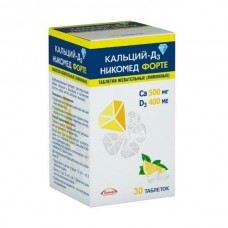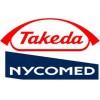Expiration date: 08/2026
The composition and form of issue:
Chewable tablets, 1 tablet contains:
calcium carbonate 1250 mg
(corresponding to 500 mg calcium)
cholecalciferol (vitamin D3) 400 IU (10 µg)
excipients: sorbitol isomalt povidone magnesium stearate aspartame lemon oil mono-, diglycerides of fatty acids
in polyethylene bottles for 30, 60 or 120 PCs.
Description pharmaceutical form:
Round, biconvex tablets without shell, white color, with lemon fragrance. May have small inclusions and uneven edges.
Pharmacokinetics:
Vitamin D3 is absorbed in the small intestine. Calcium is absorbed in the ionized form in the proximal small intestine by active, D-vitaminzawisimah transport mechanism.
Description pharmacological action:
Regulates the metabolism of calcium and phosphorus in the body (bones, teeth, nails, hair, muscles). Decreases resorption (resorption) and increase bone density, offsetting the lack of calcium and vitamin D3 in the body, essential for mineralization of teeth.
Calcium is involved in the regulation of nerve conduction, muscle contraction and is a component of the blood coagulation system.
Vitamin D3 increases calcium absorption in the intestine.
The use of calcium and vitamin D3 prevents increase the production of parathyroid hormone (PTH), which stimulates increased bone resorption (leaching of calcium from bones).
Indications:
- prevention and complex therapy of osteoporosis and its complications (bone fractures)
- a deficiency of calcium and/or vitamin D3.
Contraindications:
- hypersensitivity to one component of the drug
- hypercalcemia, hypercalciuria
- stone
- hypervitaminosis of vitamin D
- severe renal insufficiency
- active tuberculosis
- sarcoidosis
- children up to age 3 years.
With caution:
- pregnancy
- lactation.
Application of pregnancy and breast-feeding:
During pregnancy the daily dose should not exceed 1500 mg calcium and 600 IU of vitamin D3.
Hypercalcemia that develops on the background of overdose during pregnancy, can cause defects in physical and mental development of the child.
Vitamin D and its metabolites can penetrate into breast milk, therefore it is necessary to consider the intake of calcium and vitamin D from other sources in the mother and child.
Side effects:
Allergic reactions, dysfunction of the gastrointestinal tract (constipation or diarrhea, flatulence, nausea, abdominal pain) hypercalcemia and hypercalciuria (increased calcium levels in the blood or urine).
Drug interactions:
The activity of vitamin D3 may be reduced at its simultaneous application with phenytoin or barbiturates.
In concurrent treatment with cardiac glycosides requires control of ECG and clinical status, as calcium can potenzirovti therapeutic and toxic effects of cardiac glycosides.
Calcium and vitamin D3 can increase the absorption of tetracyclines from the gastrointestinal tract. Therefore, the time interval between drug tetracycline and Calcium-D3 Nycomed Forte should be at least 3 hours.
To prevent reducing the absorption of bisphosphonates or sodium fluoride, it is recommended to take Calcium-D3 Nycomed Forte no earlier than 2 h after their admission.
Corticosteroids reduce calcium absorption, so treatment with corticosteroids may require increasing the dose of Calcium-D3 Nycomed Forte.
Concomitant treatment with drugs holestiramina or laxatives based on mineral or vegetable oil may reduce the absorption of vitamin D3.
With simultaneous use of thiazide diuretics series increases the risk of hypercalcemia, because they increase tubular reabsorption of calcium. On the contrary, furosemide and other loop diuretics increase calcium excretion by the kidneys.
In patients who are concomitantly receiving cardiac glycosides and/or diuretics, it is necessary to control the concentration of calcium and creatinine in the serum.
Method of application and dose:
Inside, chewing or dissolving, mainly during meals. For prevention of osteoporosis — on 1 tab. 2 times daily in the treatment of osteoporosis — on 1 tab. 2-3 times a day.
To fill the shortage of calcium and vitamin D: adults and children over 12 years — 2 table. per day, children 3-12 years — 1 table. a day or as directed by your doctor.
Overdose:
Symptoms: anorexia, thirst, polyuria, loss of appetite, dizziness, fainting, weakness, nausea, vomiting, hypercalciuria, hypercalcemia gipercreatininemia. Long-term use of excessive doses — calcification of vessels and tissues.
Treatment: you Should consult a doctor. The introduction into the organism of large amounts of fluid, the appointment of loop diuretics, corticosteroids, calcitonin, bisphosphonates.
In the case of the development of clinical symptoms of overdosage, should determine the concentration of calcium and creatinine in the blood. At elevated concentrations of creatinine and calcium in the blood it is necessary to reduce the dose or temporarily discontinue treatment.
In the case of hypercalciuria, exceeding 7.5 mmol/day (300 mg/day), it is necessary to reduce the dose or stop taking.
Precautions:
Tablets of Calcium-D3 Nycomed Forte contain aspartame and should not be taken with phenylketonuria.
In order to avoid the overdose it is necessary to take into account the additional income of vitamin D3 from other sources.
The intake of foods containing oxalates (sorrel, spinach) and phytin (cereals) reduces calcium absorption, so should not take Calcium-D3 Nycomed Forte within 2 hours after ingestion of sorrel, spinach, products from cereals.
The drug should be used with caution in immobilised patients with osteoporosis due to the risk of hypercalcaemia.




